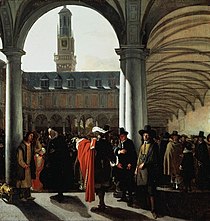
Dutch Republic
Until the 16th century, the Low Countries – corresponding roughly to the present-day Netherlands, Belgium, and Luxembourg – consisted of a number of duchies, counties, and Prince-bishoprics, almost all of which were under the supremacy of the Holy Roman Empire, with the exception of the county of Flanders, which was under the Kingdom of France.
Most of the Low Countries had come under the rule of the House of Burgundy and subsequently the House of Habsburg. In 1549Holy Roman Emperor Charles V issued the Pragmatic Sanction, which further unified the Seventeen Provinces under his rule. Charles was succeeded by his son, King Philip II of Spain. In 1568 the Netherlands, led by William I of Orange, revolted against Philip II because of high taxes, persecution of Protestants by the government, and Philip's efforts to modernize and centralize the devolved-medieval government structures of the provinces.[15] This was the start of the Eighty Years' War.
In 1579 a number of the northern provinces of the Low Countries signed the Union of Utrecht, in which they promised to support each other in their defence against the Spanish army. This was followed in 1581 by the Act of Abjuration, the declaration of independence of the provinces from Philip II.
In 1582 the United Provinces invited Francis, Duke of Anjou to lead them; but after a failed attempt to take Antwerp in 1583, the duke left the Netherlands again. After the assassination of William of Orange (10 July 1584), both Henry III of France andElizabeth I of England declined the offer of sovereignty. However, the latter agreed to turn the United Provinces into aprotectorate of England (Treaty of Nonsuch, 1585), and sent the Earl of Leicester as governor-general. This was unsuccessful and in 1588 the provinces became a confederacy. The Union of Utrecht is regarded as the foundation of the Republic of the Seven United Provinces, which was not recognized by the Spanish Empire until the Peace of Westphalia in 1648.
During the Anglo-French war (1778), the internal territory was divided into groups: the Patriots, who were pro-French and pro-American and the Orangists, who were pro-British.[16] The Republic of the United Provinces faced a series of republican revolutions in 1783–87. During this period, republican forces occupied several major Dutch cities. Initially on the defence, the Orangist forces received aid from Prussian troops and retook the Netherlands in 1787. The republican forces fled to France, but then successfully re-invaded alongside the army of the French Republic (1793–95), ousting stadtholder William V, abolishing the Dutch Republic and replacing it with the Batavian Republic (1795–1806). After the French Republic became the French Empire under Napoleon, the Batavian Republic was replaced by the Napoleonic Kingdom of Holland (1806–10).
The Netherlands regained independence from France in 1813. In the Anglo-Dutch Treaty of 1814 the names "United Provinces of the Netherlands" and "United Netherlands" were used. In 1815 it was rejoined with the Austrian Netherlands and Liège (the "Southern provinces") to become the Kingdom of the Netherlands, informally known as the Kingdom of the United Netherlands, to create a strong buffer state north of France. On 16 March 1815, the son of stadtholder William V crowned himself King William I of the Netherlands. Between 1815 and 1890 the King of the Netherlands was also in a personal union the Grand Duke of the sovereign Grand Duchy of Luxembourg. After Belgium gained its independence in 1830, the state became unequivocally known as the "Kingdom of the Netherlands", as it remains today.
Economic perspective
During the Dutch Golden Age in the late 16th century onward, the Dutch Republic dominated world trade in the 17th century, conquering a vast colonial empire and operating the largest fleet of merchantmen of any nation. The County of Holland was the wealthiest and most urbanized region in the world.
The free trade spirit of the time received a strong augmentation through the development of a modern, effective stock market in the Low Countries.[17] The Netherlands has the oldest stock exchange in the world, founded in 1602 by the Dutch East India Company. WhileRotterdam has the oldest bourse in the Netherlands, the world's first stock exchange – that of the Dutch East-India Company – went public in six different cities. Later, a court ruled that the company had to reside legally in a single city, so Amsterdam is recognized as the oldest such institution based on modern trading principles. While the banking system evolved in the Low Countries, it was quickly incorporated by the well-connected English, stimulating English economic output.
Between 1590 and 1712 the Dutch also possessed one of the strongest and fastest navies in the world, allowing for their varied conquests, including breaking the Portuguese sphere of influence on the Indian Ocean and in the Orient, as well as a lucrative slave trade from Africa and the Pacific.

No comments:
Post a Comment